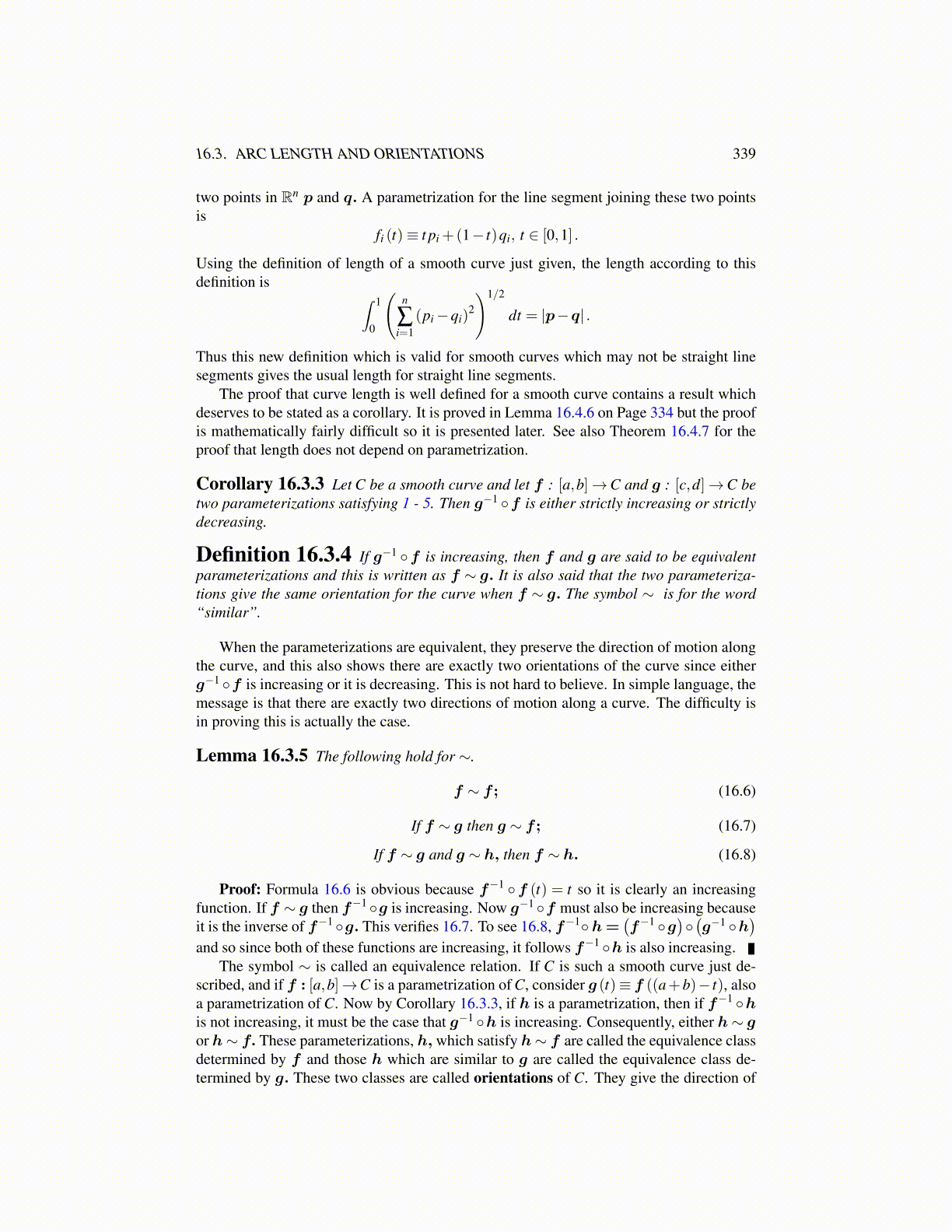
16.3. ARC LENGTH AND ORIENTATIONS 339
two points in Rn p and q. A parametrization for the line segment joining these two pointsis
fi (t)≡ t pi +(1− t)qi, t ∈ [0,1] .
Using the definition of length of a smooth curve just given, the length according to thisdefinition is ∫ 1
0
(n
∑i=1
(pi −qi)2
)1/2
dt = |p−q| .
Thus this new definition which is valid for smooth curves which may not be straight linesegments gives the usual length for straight line segments.
The proof that curve length is well defined for a smooth curve contains a result whichdeserves to be stated as a corollary. It is proved in Lemma 16.4.6 on Page 342 but the proofis mathematically fairly difficult so it is presented later. See also Theorem 16.4.7 for theproof that length does not depend on parametrization.
Corollary 16.3.3 Let C be a smooth curve and let f : [a,b]→C and g : [c,d]→C betwo parameterizations satisfying 1 - 5. Then g−1 ◦f is either strictly increasing or strictlydecreasing.
Definition 16.3.4 If g−1 ◦f is increasing, then f and g are said to be equivalentparameterizations and this is written as f ∼ g. It is also said that the two parameteriza-tions give the same orientation for the curve when f ∼ g. The symbol ∼ is for the word“similar”.
When the parameterizations are equivalent, they preserve the direction of motion alongthe curve, and this also shows there are exactly two orientations of the curve since eitherg−1 ◦f is increasing or it is decreasing. This is not hard to believe. In simple language, themessage is that there are exactly two directions of motion along a curve. The difficulty isin proving this is actually the case.
Lemma 16.3.5 The following hold for ∼.
f ∼ f ; (16.6)
If f ∼ g then g ∼ f ; (16.7)
If f ∼ g and g ∼ h, then f ∼ h. (16.8)
Proof: Formula 16.6 is obvious because f−1 ◦f (t) = t so it is clearly an increasingfunction. If f ∼ g then f−1 ◦g is increasing. Now g−1 ◦f must also be increasing becauseit is the inverse of f−1 ◦g. This verifies 16.7. To see 16.8, f−1◦h=
(f−1 ◦g
)◦(g−1 ◦h
)and so since both of these functions are increasing, it follows f−1 ◦h is also increasing.
The symbol ∼ is called an equivalence relation. If C is such a smooth curve just de-scribed, and if f : [a,b]→C is a parametrization of C, consider g (t)≡ f ((a+b)− t), alsoa parametrization of C. Now by Corollary 16.3.3, if h is a parametrization, then if f−1 ◦his not increasing, it must be the case that g−1 ◦h is increasing. Consequently, either h∼ gor h∼ f. These parameterizations, h, which satisfy h∼ f are called the equivalence classdetermined by f and those h which are similar to g are called the equivalence class de-termined by g. These two classes are called orientations of C. They give the direction of